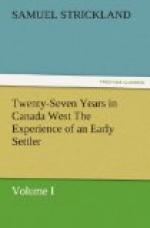For four days and three nights did this poor fellow wander through these rugged wilds. On the afternoon of the fourth day he came upon a ridge of land, which appeared better timbered and more open; so he determined to follow this route, expecting it might lead him to the lakeshore, where his camp was situated.
He had not walked a hundred yards in this new direction, when to his surprise he saw quite a fresh blaze on a tree, and within a fear yards of the spot on which he stood, a newly constructed marten-trap. Words cannot express the joy he felt at this discovery; it was his own line he had so fortunately come upon. Had he only gone the smallest distance to his left, he would have missed it altogether; but he came, providentially, upon the very spot where he had set his last trap, and within a few feet of the place he had left four days before.
On his way to the camp, a sudden fear came over him! Had his companion left it, supposing him to be irrecoverably lost? If so, what was to become of him on the north shore of Stony Lake, without a canoe to cross over to the settlement, food, or ammunition to procure any for his support. His fears were, however, groundless, as the report of a gun, and soon after the appearance of his companion convinced him; but the danger had been great; for, from the statement of his fellow-trapper, he found that the latter was then on his way to the end of the line, hoping that he might see or hear something of him before he broke up their camp, which he intended to have done in the morning, if he had not unexpectedly fallen in with his friend. Thus had Providence again interposed in his behalf, and a few days of rest restored him to his wonted health, spirits, and activity.
CHAPTER XIII.
DIRECTIONS FOR ASCERTAINING THE QUALITY OF LAND IN THE BUSH. — SITE OF LOG-SHANTY. — CHOPPING. — PREPARATION FOR SPRING-CROPS. — METHOD OF PLANTING INDIAN CORN. — PUMPKINS AND POTATOES. — MAKING POT-ASH.
I shall now endeavour to give the emigrant some information to guide him in the selection of his land, and other matters connected with a settlement in the bush. In the first place, the quality of the land is the greatest consideration, and to make a good choice requires a practical knowledge as to the nature of the soils, and the different kinds of timber growing thereon.
The best land is timbered with oak, ash, elm, beech, bass-wood, and sugar maple. A fair mixture of this species of trees is best, with here and there a large pine, and a few Canadian balsams scattered among the hard-wood. Too great a proportion of beech indicates sand or light loam: a preponderance of rock elm is a sign of gravel or limestone-rock near the surface.
The timber should be lofty, clean in the bark and straight in the grain, and of quick growth. The woods should be open, free from evergreens, and with little under-brush. Generally speaking, the soil is of excellent quality, when timbered in the manner described.




